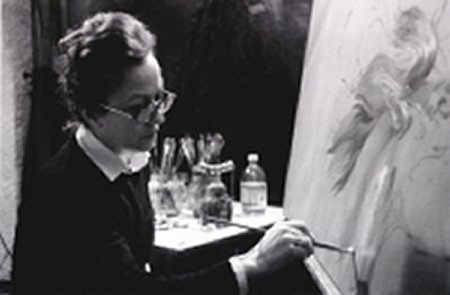
THESEO
The Art of Antonella Cappuccio in the Labyrinth of the soul

Antonella
Cappuccio
Antonella Cappuccio was born in Ischia (Naples),
but she soon moved to Rome, where she still lives and works. Since a young girl,
at first as a scene and costume designer, she grows the passion for art and
stylistic practise, improving her capability in tecniques and crafts to devote
herself completely to painting, aware of purposes of the artistical mean and of
the will to tell by drawing and colour.
In 1976 she starts to exibit according to an
aesthetic project that shows soon the will to display her spiritual journey
through images and to paint on canvas figurative systems based on concrete ideas.
 The
twenty-one paintings of the "Orpheus" collection (works from 1976 to
1987) are significant in this sense :the artist deals with the complicate theme
of human passions, illustrated by a refined use of symbol, where soul
rises-sometimes painfully-from interaction between man and what surrounds him.
The
twenty-one paintings of the "Orpheus" collection (works from 1976 to
1987) are significant in this sense :the artist deals with the complicate theme
of human passions, illustrated by a refined use of symbol, where soul
rises-sometimes painfully-from interaction between man and what surrounds him.
It's immediately evident that the artist's
ideological choice is to read and tell man history in allegorical terms, doing
without space-time references and without losing its topicalicaty, to entrust
the speech of being to memory.
The drama of lost paradise and endless
nostalgia for origins, evoked by mith, reappear in this period's works. Colours,
light and shadows effects, the skilled use of hatching, contribute to pregnant
and evasive forms, attracting and alienating, a ripening expressions of art
history as aesthetic epiphany.
In 1983 Antonella Cappuccio joins "the
New Italian Manner" with other artists who hold very similar views to hers
: Bruno D'Arcevia, Renato Nosek, Vittoria Scialoja; all of them start a group, a
new school that has been gradually enriched by other contributions and earns the
first extraordinary success in the Los Angeles exhibitions at the end of 1988
and in 1993.
In 1985 Antonella Cappuccio presents her
first exhibition conceived according to the New Italian Manner canons ; other
exhibitions which gather and synthetize previous works and new productions
follow in Rome, then the 1987 solo exhibitions in Milan (the above mentioned
"Orpheus"), in 1988 in Lyon, in 1989 in Los Angeles, as well as many
group exhibitions, among which the 1986 XI
Quadriennale d'Arte in Rome, in 1988 at the Florence Palazzo Strozzi,
the Venice Biennale d'Arte Sacra in 1987, in Los Angeles again in 1989 ("Four
artists of the New Italian Manner"), in Rio de Janeiro and in Bari, then in
1990 in Rome.
During the following years, Antonella
Cappuccio's human and artistic journey has became progressively different from
the New Italian Manner, according to a spiral movement that rediscovers the
symbol of human soul.
 The
1998 solo exhibition "Amor
del Sacro, Amor del Profano" at the Mantua Palazzo Ducale is emblematic
about that : " a refined analysis of costume's cromatic and symbolic values
in an imaginary actorless play, by composite figures which swarm in the back
ground's depth, and which trasform themselves into a fickle allegory of feelings
evoked by the clothes".
The
1998 solo exhibition "Amor
del Sacro, Amor del Profano" at the Mantua Palazzo Ducale is emblematic
about that : " a refined analysis of costume's cromatic and symbolic values
in an imaginary actorless play, by composite figures which swarm in the back
ground's depth, and which trasform themselves into a fickle allegory of feelings
evoked by the clothes".